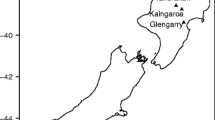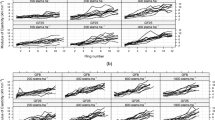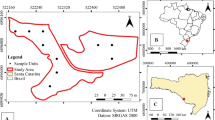Abstract
• Contex t
While numerous studies have considered the effects of initial planting spacing on wood properties, little is known about the properties of trees grown from dense natural regeneration and the effects of early release from competition.
• Aims
This study examined 40-year-old Sitka spruce (Picea sitchensis (Bong.) Carr.) trees originating from regeneration with an initial density ∼27,000 stems ha−1.
• Methods
Treatments were a control of natural regeneration with no interventions and regeneration re-spaced to two metres (height ∼1.6 m). Density and strength measurements were made on the juvenile and mature wood.
• Results
No differences were observed in density, modulus of elasticity (MOE) and modulus of rupture (MOR) between the juvenile and mature wood of the control trees. By contrast, the juvenile wood of re-spaced trees was less dense and had a lower MOE than the mature wood.
• Conclusion
The control trees revealed a uniformity of properties across the juvenile and mature wood zones, unlike the re-spaced treatment. Re-spaced trees appear to adapt to their new environment by producing more thin-walled conductive tissue and lowering overall cell wall density that continues from the juvenile to mature wood. Higher compression wood levels in the control trees are thought to be linked to stem slenderness.


Similar content being viewed by others
References
Barger RL, Ffolliott PF (1976) Factors affecting occurrence of compression wood in individual ponderosa pine trees. Wood Sci 8:201–208
Brazier JD (1965) An assessment of the incidence and significance of spiral grain in young conifer stems. Forest Prod J 15:308–312
Brazier JD, Mobbs ID (1993) The influence of planting distance on structural wood yields of unthinned Sitka spruce. Forestry 66:333–352
Burschel P, Huss J (1987) Grundriβ des Waldbaus. Verlag Paul Parey, Hamburg and Berlin, 352 pp
Cameron AD (2002) Importance of early selective thinning on the development of long-term stand stability and improved log quality: a review. Forestry 75:25–35
Cameron AD, Thomas K (2008) Effect of thinning on the development of compression wood in stems of Corsican pine. Eur J For Res 127:247–251
Cameron AD, Lee SL, Livingston AK, Petty JA (2005) Influence of selective breeding on the development of juvenile wood in Sitka spruce. Can J For Res 35:2951–2960
Clarke GC (1992) The natural regeneration of spruce. Scott For 46:107–129
Cregg BM, Dougherty PM, Hennessey TC (1998) Growth and wood quality of young loblolly pine trees in relation to stand density and climatic factors. Can J For Res 18:851–858
Desch HE, Dinwoodie JM (1996) Timber—structure, properties, conversion and use, 7th edn. Macmillan, Basingstoke, 320 pp
Dinwoodie JM (2000) Timber: its nature and behaviour, 2nd edn. E & FN Spon, New York, 257 pp
Domec JC, Gartner BL (2002) How do water transport and water storage differ in coniferous earlywood and latewood? J Exp Bot 53:2369–2379
Lasserre JP, Mason EG, Watt MS (2004) The influence of initial spacing on corewood modulus of elasticity in a clonal experiment of 11-year-old Pinus radiata D. Don. N Z J For 49:18–23
Macdonald E, Hubert J (2002) A review of the effects on timber quality of Sitka spruce. Forestry 75:107–138
Macdonald E, Gardiner BA, Mason WL (2010) The effects of transformation of even-aged stands to continuous cover forestry on conifer log quality and wood properties in the UK. Forestry 83:1–16
Mason WL (2008) Natural regeneration of Sitka spruce in the Forest of Ae: development over 25 years. Scott For 62:2–9
Mason WL (2010) Respacing naturally regenerating Sitka spruce and other conifers. Forestry Commission Practice Note FCPN016
McLean JP, Evans R, Moore JR (2010) Predicting the longitudinal modulus of elasticity of Sitka spruce from cellulose orientation and abundance. Holzforschung 64:495–500
McLean JP, Zhang T, Bardet S, Beauchêne J, Thibaut A, Clair B, Thibaut B (2011) The decreasing radial wood stiffness pattern of some tropical trees growing in the primary forest is reversed and increases when they are grown in a plantation. Ann For Sci 68:681–688
Moore J, Achim A, Lyon A, Mochan S, Gardiner B (2009) Effects of early re-spacing on the physical and mechanical properties of Sitka spruce structural timber. For Ecol Manag 258:1174–1180
Olesen PO (1971) The water displacement method. A fast and accurate method of determining the green volume of wood samples. For Tree Improve Aboric Horsholm 3:3–23
Oliver CD, Larson BC (1996) Forest stand dynamics. John Wiley and Sons Inc., New York, 520 pp
Panshin AJ, de Zeeuw C (1980) Textbook of wood technology, 4th edn. McGraw-Hill, New York, 722 pp
Pape R (1999) Effects of thinning regime on the wood properties and stem quality of Picea abies. Scand J For Res 14:38–50
Peterson EB, Peterson NM, Weetman GF, Martin PJ (1997) Ecology and management of Sitka spruce: emphasising its natural range in British Columbia. UBC Press, Vancouver, 336 pp
Pillow MY (1941) A new method of detecting compression wood. J For 39:385–387
Pillow MY, Luxford RF (1937) Structure, occurrence and properties of compression wood. US Department of Agriculture Technical Bulletin 546. 32 pp
Reader TG, Kurmes EA (1996) The influence of thinning to different stocking levels on compression wood development in ponderosa pine. For Prod J 46:92–100
Renninger HJ, Gartner BL, Meinzer FC (2006) Effects of release from suppression on wood functional characteristics in young Douglas fir and western hemlock. Can J For Res 36:2038–2046
Renninger HJ, Meinzer FC, Gartner BL (2007) Hydraulic architecture and photosynthetic capacity as constraints on release from suppression in Douglas fir and western hemlock. Tree Physiol 27:33–42
Smith DM, Larson BC, Kelty MJ, Ashton PMS (1997) The practice of silviculture: applied forest ecology, 9th edn. John Wiley & Sons, New York, 537 pp
SPSS (2010) IBM SPSS Statistics vs. 19. Chicago, US
Timell TE (1986) Compression wood in gymnosperms. Springer, Berlin, 2150 pp
Waghorn MJ, Mason EG, Watt MS (2007) Influence of initial stand density and genotype on longitudinal variation in modulus of elasticity for 17-year-old Pinus radiata. For Ecol Manag 252:67–72
Wang SY, Ko CY (1998) Dynamic modulus of elasticity and bending properties of large beams of Taiwan-grown Japanese cedar from different plantation spacing sites. J Wood Sci 44:62–68
Watt MS, Moore JR, Facon J-P, Downes GM, Clinton PW, Coker G, Davis MR, Simcock R, Parfitt RL, Dando J, Mason EG, Brown HE (2006) Modelling the influence of stand structural, edaphic and climatic influences on juvenile Pinus radiata dynamic modulus of elasticity. Forest Ecol Manag 229:136–144
Zhang SY (1997) Wood quality: its definition, impact and implications for value-added timber management and end uses. In Timber Management Toward Wood Quality and End-Product Value. S.Y. Zhang, R. Gosselin and G. Chauret (eds). Proceedings of the CTIA/IUFRO International Wood Quality Workshop, Quebec City. Part I. pp 17-39
Zhang SY, Chauret G, Ren HQ, Desjardins R (2002) Impact of initial spacing on plantation black spruce lumber grade yield, bending properties and MSR yield. Wood Fibre Sci 34:460–475
Acknowledgments
The authors would like to thank Shaun Mochan and Colin McEvoy of Forest Research for their assistance in the collection of the sample trees, to Douglas Proudfoot of the University of Aberdeen for his meticulous preparation of the wood samples, to Gavin Davies and Adam Mclean for assistance with the laboratory work and to Bill Mason of Forest Research for his earlier work at the experimental site that inspired the current study.
Author information
Authors and Affiliations
Corresponding author
Additional information
Handling Editor: Jean-Michel Leban
Contribution of the co-authors
The second author was involved with setting up the project and providing guidance throughout. The third and fourth authors carried out most of the field work. The first author proposed the study, set up the funding, carried out most of the data analysis and drafted the paper.
Rights and permissions
About this article
Cite this article
Cameron, A.D., Gardiner, B.A., Ramsay, J. et al. Effect of early release from intense competition within high density natural regeneration on the properties of juvenile and mature wood of 40-year-old Sitka spruce (Picea sitchensis (Bong.) Carr.). Annals of Forest Science 72, 99–107 (2015). https://doi.org/10.1007/s13595-014-0402-4
Received:
Accepted:
Published:
Issue Date:
DOI: https://doi.org/10.1007/s13595-014-0402-4




